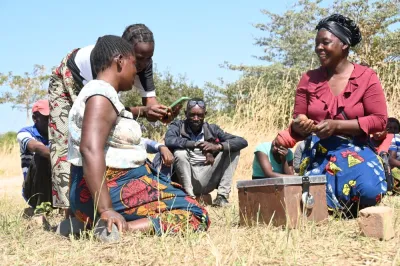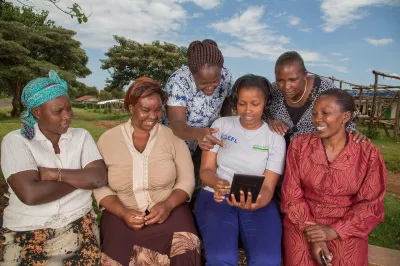Combating Financial Abuse With a Vigorous Battle Plan

People often turn a blind eye to financial abuse. They may not be sure how to identify it or how to help stop it. Even when they know it is happening in a household, they may feel that what goes on inside a family is none of their business.
The good news, however, is that financial service providers hold a unique position which gives them an array of potential actions to combat this threat to many people’s wellbeing. What’s more, these actions are well within their purview and capacity.
The Grameen Foundation and other organizations are currently working to identify and gather good practices that are scattered across financial sectors in various countries and to adapt them for institutions serving people who live on low incomes. Practices range from basic account design to front-line staff sensitization to raising awareness among consumers. The aim of Grameen Foundation’s work is to create a core set of good practices for financial service providers.
But how do we move from some good practices deployed by a few highly motivated service providers to the sector-wide implementation that would make a real difference? It is a daunting challenge for any one organization to take on.
Three key lessons from the Smart Campaign we can apply to a campaign against financial abuse
That said, I have seen first-hand that the financial inclusion community can address daunting and sensitive challenges. During the global financial crisis of 2009, a few actors within the microfinance sector began calling for greater client protections. At the Center for Financial Inclusion at Accion, together with CGAP, we created the Smart Campaign to promote client protection standards. Over the next several years the Smart Campaign’s Client Protection Principles and the accompanying standards permeated the sector. And, after a hand-off to the Social Performance Task Force and Cerise, the tenets and tools of the Smart Campaign continue as a cornerstone of microfinance institutions (MFIs) globally.
This change did not happen by accident: it was a concerted campaign with a battle plan deployed over several years and with the generous support of the MasterCard Foundation and others.
Coming back to today, Here’s what we need to do:
1. Develop political will. Raising political will involves convincing a core group of high-profile leaders to commit. In the case of the Smart Campaign, factors such as the global financial crisis and the rise of profit-seeking in microfinance pushed client protection forward. Sector leaders came together and created a broad consensus for action. Once a key group of sector leaders committed, all else followed, including funding for the Campaign, early implementors and tool development. To broaden political will beyond the initial group, the Campaign leveraged incentives facing financial institutions (through investors, customers, public opinion and eventually, regulators). Over time, it became essential for microfinance institutions in good standing to embrace client protection.
The sensitivity of financial abuse, and its hidden nature, may make it more challenging to convince financial service providers to take it on. The initial leaders should include providers, investors, regulators and researchers. Political will is especially necessary given that actions would be voluntary, just as consumer protection was largely voluntary for microfinance institutions when the Smart Campaign began. Gender sensitization training may be one way of creating the initial sense of urgency and possibility among selected leaders.
2. Craft the tools. Today, with a relatively limited state of know-how on combating financial abuse, action research is a top priority. While Grameen Foundation has a good start on effective practices, it will be essential over the next few years to test and apply these in real life settings. Action research projects allow multiple financial institutions to implement programs, compare experiences and evaluate outcomes. From this research, a body of knowledge will emerge that can be distilled into messages and toolkits that are easy for other institutions to adopt. Financial institutions need proven checklists and protocols, with guidance and training on how to apply them. For example, the Smart Campaign developed detailed standards, deep dives on specific topics, self-assessment tools, staff training programs and more.
3. Communicate energetically. To help spread the Smart Campaign’s message throughout the sector, a communications campaign was essential. We took advice from a group of experienced political campaign consultants who recommended the name, a tag line (“It’s the right thing to do; it’s the smart thing to do”), a logo (caring hands), and a continual stream of messaging. These simple essentials, coupled with the deep body of materials, made the campaign easy to identify with and learn from. Our communications strategy emphasized positives and successes rather than the many possible horror stories the topic could engender, making it easier for financial institutions to join in. We showcased individual star performers, discussed specific consumer protection topics and advertised tools. The Smart Campaign “brand,” designed to appeal to values and emotion, created a sense of possibility and momentum, making people in the target institutions want to join the movement.
A communications strategy like this will be particularly important for a campaign against financial abuse, to make sure that messages stay focused on successes and the potential for overcoming this difficult issue, instead of getting bogged down with a negative narrative that can make the issue feel too overwhelming to confront.
It’s time to come together to combat financial abuse
These actions required sustained funding, which political will made possible. Relative to the scale of the problem, the funding requirements for the campaign were moderate. The same would be true for a campaign against financial abuse.
In view of the great harm done through intra-family financial abuse, especially to women, and the existence of actions that can combat it, I urge leaders in the financial inclusion sector to come together behind an energetic campaign.
See Grameen Foundation’s Project SAFE blog series for more on the content and status of this work, as well as background on financial abuse and how pervasive and damaging it is.


